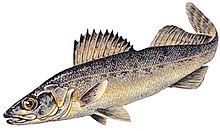Blue walleye
| Blue walleye | |
|---|---|

| |
Extinct (1983)
| |
| Scientific classification (invalid taxon) | |
| Domain: | Eukaryota |
| Kingdom: | Animalia |
| Phylum: | Chordata |
| Class: | Actinopterygii |
| Order: | Perciformes |
| Family: | Percidae |
| Subfamily: | Luciopercinae |
| Genus: | Sander |
| Species: | S. vitreus |
| Subspecies: | †S. v. glaucus
|
| Trinomial name | |
| †Sander vitreus glaucus (Hubbs, 1926)
| |
| Synonyms | |
The blue walleye (Sander vitreus var. glaucus), also called the blue pike, was a unique color morph (formerly considered a subspecies) of walleye which was endemic to the Great Lakes of North America. Morphometric studies led biologists to classify the blue walleye as a separate species in 1926, although it was later downgraded to a subspecies. Listed as an endangered species by the United States in 1967, it was declared extinct in 1983.
Genetic analyses conducted in the 21st century show that the blue walleye was not genetically different from the yellow walleye (Sander vitreus), rendering the taxon invalid.
Species controversy

The blue walleye was long considered to be different from the yellow walleye.[1] Based on morphological study, Carl Leavitt Hubbs declared the blue walleye to be a separate species in 1926.[2] The species was later downgraded to a subspecies.[3]
The blue walleye was a commercially valuable fish in the Great Lakes. Populations appeared to collapse quickly in the 1950s. Between 1950 and 1957, catches in the U.S. and Canada fluctuated between 2,000,000 pounds (910,000 kg) and 26,000,000 pounds (12,000,000 kg) a year. In 1959, however, just 79,000 pounds (36,000 kg) were caught, and in 1964 only 200 pounds (91 kg).[4] The United States declared blue walleye an endangered species in 1967,[5][6][7] and extinct in 1983.[8][6][9]
A 2014 genetic study of 1,181 preserved "historic" walleye (70 to 90 years old), blue walleye/blue pike, and modern walleye found no evidence for concluding that blue walleye/blue pike were genetically distinct from other walleye.[10] This rendered the taxon invalid.[11]
Occasionally, grey-blue or steel-blue walleye are caught in Lake Erie, Lake Ontario, and the Ohio River drainage.[12] Dark blue yellow perch are also sometimes caught in the same areas.[13]
A turquoise-colored walleye exists in some waters of the Canadian Shield.[14] A mucosal pigment, named "sandercyanin", was hypothesized to be the source of the color,[15] but this has not been confirmed.[16] This fish was also thought to be a separate subspecies of walleye, but genetic testing showed there is no difference between the turquoise walleye and yellow walleye.[11]
Description
Sander vitreus "glaucus" also known as the "blue pike" is endemic to Lakes Erie and Ontario and co-occurred with Sander vitreus vitreus. It is compared to the walleye in many aspects however, the "blue pike" inhabits the deeper and cooler areas of Lake Erie but was also seen in shallow and warmer areas alongside the walleye. In comparison to the walleye the "blue pike" has a steel blue color, larger eyes placed bit higher than the walleyes eye placement, and the eye distance is smaller as well. [17]
References
- ISBN 9780814324707.
- ISBN 084931920X.
- OCLC 5525598.
- ISBN 9780814202135.
- ISBN 9780385498814.
- ^ a b "Blue pike (Stizostedion vitreum glaucum)". Environmental Conservation Online System. U.S. Fish & Wildlife Service. Retrieved 30 April 2023.
- ^ 32 FR 4001
- ISBN 9780374246648.
- ^ 48 FR 39941
- PMID 24941945.
- ^ ISBN 9789401772266.
- OCLC 256035728. Retrieved April 27, 2018; "Fish thought extinct caught in Tennessee". United Press International. February 9, 2012. Retrieved September 30, 2018; "Blue pike extinct, but did they ever really exist?". The Coloradoan. March 19, 2014. Retrieved September 30, 2018; Bowman, Dale (July 11, 2016). "Blue pike, silver pike, walleye: Tracking fishing mystery and words". Chicago Sun-Times. Retrieved September 30, 2018.
- OCLC 256035728. Retrieved April 27, 2018.
- S2CID 22471516. Retrieved April 27, 2018.
- S2CID 20912874.
- S2CID 22471516. Retrieved April 27, 2018.
- PMID 24941945.
Further reading
- Hubbs, Carl L. (1926). A Check-List of the Fishes of the Great Lakes and Tributary Waters, with Nomenclatorial Notes and Analytical Keys. University of Michigan Museum of Zoology Special Publications No. 15. Ann Arbor: University of Michigan. 77 pp. + Plates I-IV. (Stizostedion glaucum, new species, pp. 58–59 + Plate IV, figure 2).
- Trautman, Milton B. (1981). The Fishes of Ohio. Columbus, Ohio: Ohio State University Press. 782 pp. ISBN 978-0814202135. (Stizostedion vitreum glaucum, new combination).
